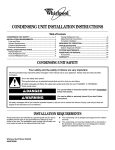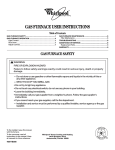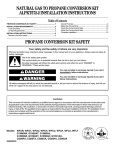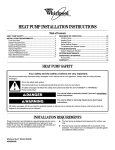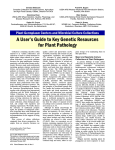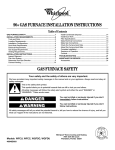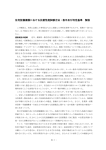Download Whirlpool GOLD W4GH6 Specifications
Transcript
HEAT PUMP INSTALLATION INSTRUCTIONS Table of Contents HEAT PUMP SAFETY.....................................................................1 INSTALLATION REQUIREMENTS ................................................1 Tools and Parts ............................................................................2 System Requirements..................................................................2 Location Requirements ................................................................2 Electrical Requirements ...............................................................3 INSTALLATION INSTRUCTIONS ..................................................4 Inspect Shipment .........................................................................4 Connect Refrigerant Lines ...........................................................4 Charge Refrigerant Lines .............................................................5 Make Electrical Connections .......................................................8 Complete Installation..................................................................10 SEQUENCE OF OPERATION ......................................................11 Cooling Cycle .............................................................................11 Heating Cycle .............................................................................11 Defrost Cycle..............................................................................11 Adjust Defrost System ...............................................................12 Troubleshoot the Defrost System ..............................................13 SYSTEM MAINTENANCE ............................................................13 ASSISTANCE OR SERVICE .........................................................13 Accessories ................................................................................13 WARRANTY ..................................................................................14 HEAT PUMP SAFETY Your safety and the safety of others are very important. We have provided many important safety messages in this manual and on your appliance. Always read and obey all safety messages. This is the safety alert symbol. This symbol alerts you to potential hazards that can kill or hurt you and others. All safety messages will follow the safety alert symbol and either the word “DANGER” or “WARNING.” These words mean: DANGER WARNING You can be killed or seriously injured if you don't immediately follow instructions. You can be killed or seriously injured if you don't follow instructions. All safety messages will tell you what the potential hazard is, tell you how to reduce the chance of injury, and tell you what can happen if the instructions are not followed. INSTALLATION REQUIREMENTS These instructions are intended as a general guide only for use by qualified persons and do not supersede any national or local codes in any way. The installation must comply with all state and local codes as well as the National Electrical Code. Whirlpool Gold® Models W2GH3 48632A008 ■ ■ The heat pump is designed and approved for outdoor use only. The heat pump must be installed with no ductwork in the airstream. The outdoor fan is not designed to operate against any additional static pressure. Tools and Parts Gather the required tools and parts before starting installation. Read and follow the instructions provided with any tools listed here. Tools Needed ■ ■ Torch ¹⁄₄" (6.4 mm) nut driver ■ Parts Needed Check local codes and HVAC supplier. Check existing electrical supply, and read “Electrical Requirements,” “Location Requirements,” “System Requirements” and “Connect Refrigerant Lines.” ⁵⁄₁₆" (7.6 mm) nut driver System Requirements Heat pump system matches are derived from actual laboratory testing of matched systems. It is recommended that only matching equipment be used to ensure proper operation and efficient performance. ■ The designed system matches are listed in the heat pump specification sheets and on the heat pump refrigerant charging instructions located on the back of the service access panel. ■ Refrigerant charging instructions include a list of matching indoor equipment with the proper thermal expansion valve size and amount of refrigerant charge required. ■ This heat pump has been factory charged with a quantity of refrigerant (R-22) sufficient for a matched indoor coil and a maximum 15 ft (4.6 m) of refrigerant line. Indoor System Thermal Expansion Valve ■ ■ ■ Check the indoor coil thermal expansion valve to see whether it matches the required thermal expansion valve for the indoor coil and heat pump combination being installed. Refer to the refrigerant charge label located on the inside of the heat pump access panel for the correct thermal expansion valve size required. Replace the thermal expansion valve with the correct size if this size is not already installed in the indoor coil. Instructions for replacing the thermal expansion valve are provided with the indoor coil. Location Requirements ■ ■ ■ ■ ■ ■ 2 This heat pump is designed to be located outdoors with sufficient clearance for free entrance to the inlet and discharge air openings. The location must also allow for adequate service access. See “Minimum Clearances.” Where possible, select a location for the heat pump which is shaded from the direct rays of the sun most of the time. North or east locations are usually most desirable. Position the heat pump to avoid direct contact with water, snow or ice from a roofline overhead. The heat pump must be installed on a solid, level mounting pad that will not settle or shift. Isolate the pad from the building structure to avoid possible transmission of sound or vibration from the heat pump into the conditioned space. The heat pump foundation should be raised to a minimum of 3" (7.6 cm) above finish grade. In areas which have prolonged periods of temperatures below freezing, and/or snowfall, the heat pump should be elevated above the average snow line. If heat pump is to be installed on a flat roof, it should be on a platform or other support which will raise the inlet air opening 12" (30.5 cm) minimum above the surface of the flat roof. Avoid ice accumulation by ensuring free drainage of condensate from defrost cycles. The heat pump should be located away from walkways to avoid possible icing from defrost condensate. Avoid placing the heat pump near areas such as sleeping quarters or study rooms. Normal operating sound levels may be objectionable if the heat pump is placed near certain rooms. A shift in sound type does occur during the defrost mode. The defrost mode generally lasts no longer than 10 minutes. Minimum Clearances A B 48" (121.9 cm) Overhead Clearance (Discharge Air) ) m ) c 5 ir . 30 t A " ( le 12 e (In nc ra ea Cl C E D F G H Cl 36 ea " ra (91 nc .4 e ( cm Inl ) et Ai r) ice erv ce S ) n cm ra .2 lea 76 ss C ( " 30 cce A A. Weatherproof disconnect switch B. NEC class 1 wiring C. NEC class 2 wiring D. To power supply 12" (30.5 cm) Clearance Between Unit and Building E. House thermostat F. To indoor unit G. To indoor coil H. Seal openings Installing Vertical Runs (new construction shown) Line Set Isolation The following illustrations demonstrate procedures which ensure proper refrigerant line set isolation. This shows how to install line sets on vertical runs. NOTE: Similar installation practices should be used if line set is to be installed on exterior of outside wall. IMPORTANT: Refrigerant lines must not contact structure. Installing Horizontal Runs B This shows how to install line sets on horizontal runs. NOTES: ■ To hang line set from joist or rafter, use either metal strapping material or anchored heavy nylon wire ties. ■ Strap the vapor line to the floor joist or roof rafter at 8 ft (2.4 m) intervals, then strap the liquid line to the vapor line. A C C D H E F G H E D G A 8' C A B I C 8' J D E L E G D K H A C A. Metal strapping material (around D. Metal strapping material (around vapor line only) vapor line only) and tape or heavy nylon wire tie (around vapor and B. Floor joist or roof rafter liquid lines) C. Tape or heavy nylon wire tie E. Metal sleeve Transition from Horizontal to Vertical This shows how to make a transition from horizontal to vertical. Style 1 Electrical Requirements Style 2 A WARNING G F E E. Anchored heavy nylon wire tie J. Caulk A. Outside wall K. Fiberglass B. Space between wall F. Inside wall insulation and refrigerant line G. Metal strapping material L. PVC pipe C. Vapor line wrapped H. Metal sleeve in armaflex I. Wood block between studs D. Liquid line D B B C C Electrical Shock Hazard Electrically ground condensing unit or heat pump. F E D A. Style 1—anchored heavy nylon wire tie E. Metal sleeve B. Tape or heavy nylon wire tie holding liquid F. Wall stud line to vapor line. G. Style 2—automotive C. Liquid line muffler-type hanger D. Vapor line—wrapped in armaflex Connect ground wire to ground lug. Use copper wire for supply connection. Correct wire gauge is shown in the chart below. Failure to follow these instructions can result in death or electrical shock. Rating Plate Ampacity AWG Less than 15 14 16 - 20 12 21 - 30 10 31 - 50 8 NOTE: All outdoor wiring must be suitable for outdoor use. Use copper conductors only. 3 ■ All field wiring must be done in accordance with National Electrical Code requirements, applicable requirements of UL, or local codes, where applicable. ■ Electrical wiring, disconnect means and over-current protection are to be supplied by the installer. Refer to the rating plate for the maximum over-current protection, minimum circuit ampacity, and operating voltage. See the wiring diagrams in “Make Electrical Connections.” INSTALLATION INSTRUCTIONS Inspect Shipment WARNING Excessive Weight Hazard Use two or more people to move and install condensing unit or heat pump. Failure to do so can result in back or other injury. This heat pump is shipped in one package, completely assembled and wired. The thermostat is shipped in a separate carton when ordered. 1. Check the heat pump rating plate to confirm specifications are as ordered. 2. Upon receipt of heat pump, inspect it for possible shipping damage. Examine the heat pump inside the carton if the carton is damaged. If damage is found, it should be noted on the carrier’s freight bill. Damage claims should be filed with the carrier immediately. Claims of shortages should be filed with the seller within 5 days. NOTE: If any damages are discovered and reported to the carrier, do not install the heat pump because your claim may be denied. Connect Refrigerant Lines Refrigerant lines must be connected by a licensed, EPA certified refrigerant technician in accordance with established procedures. IMPORTANT: ■ Connecting refrigerant lines must be clean, dehydrated, refrigerant-grade copper lines. Heat pumps should be installed only with specified line sizes for approved system combinations with elevation differences up to 15 ft (4.6 m) and total length of up to 50 ft (15.2 m). See the Suction Line Sizes and Liquid Line Sizes charts. ■ Sharp bends or possible kinking in the lines will cause a reduction in performance. ■ To avoid contamination of the refrigerant system, do not remove the caps from the lines or system connection points until connections are ready to be completed. 1. Route the suction and liquid lines from the fittings on the indoor coil to the fittings on the heat pump. Run the lines in as direct a path as possible, avoiding unnecessary turns and bends. 2. For product efficiency, be sure that the suction line is insulated over the entire exposed length and that both suction and liquid lines are not in direct contact with floors, walls, ductwork, floor joists, or other piping. 3. Remove valve cores. 4. Wrap the service valves with a wet rag. 5. Connect the suction and liquid lines, using a brazing compound. Braze with an alloy of silver or copper and phosphorus with a melting point above 1,100°F (593ºC). NOTE: Do not use soft solder. 4 6. Make sure indoor coil has been put in place according to the Installation Instructions and is connected to the refrigerant lines. 7. Replace valve cores. 8. Pressurize the lines and indoor coil with a pressure not to exceed 20 psi. 9. Leak test the lines with a pressure not to exceed 20 psig. 10. Evacuate the indoor coil and lines to a minimum of 500 microns to remove contamination and moisture, then disconnect the vacuum pump. 11. Open the suction and liquid service valves fully. 12. Insulate the suction line with refrigerant line insulation material of ¹⁄₄" (6.4 mm) or more wall thickness. 13. Pack insulating material around refrigerant lines where they penetrate the structure to protect the lines and to minimize vibration transmission. A A. Insulating material around refrigerant lines Suction Line Sizes Liquid Line Sizes Installations exceeding 100 ft (30.5 m) are not recommended. Installations exceeding 100 ft (30.5 m) are not recommended. Btu/h Line Set Size—in. (cm) OD Btu/h Line Set Size—in. (cm) OD 18,000 ³⁄₄ (1.9) ³⁄₄ (1.9) ³⁄₄ (1.9) 18,000 ³⁄₈ (1) ³⁄₈ (1) ³⁄₈ (1) 24,000 ³⁄₄ (1.9) ³⁄₄ (1.9) ³⁄₄ (1.9) 24,000 ³⁄₈ (1) ³⁄₈ (1) ³⁄₈ (1) 30,000 ³⁄₄ (1.9) ³⁄₄ (1.9) ³⁄₄ (1.9) 30,000 ³⁄₈ (1) ³⁄₈ (1) ³⁄₈ (1) 36,000 ⁷⁄₈ (2.2) ⁷⁄₈ (2.2) ⁷⁄₈ (2.2) 36,000 ³⁄₈ (1) ³⁄₈ (1) ³⁄₈ (1) 42,000 ⁷⁄₈ (2.2) ⁷⁄₈ (2.2) ⁷⁄₈ (2.2) 42,000 ³⁄₈ (1) ³⁄₈ (1) ³⁄₈ (1) 48,000 ⁷⁄₈ (2.2) ⁷⁄₈ (2.2) ⁷⁄₈ (2.2) 48,000 ³⁄₈ (1) ³⁄₈ (1) ³⁄₈ (1) 60,000 1¹⁄₈ (2.9) 1¹⁄₈ (2.9) 1¹⁄₈ (2.9) 60,000 ³⁄₈ (1) ³⁄₈ (1) ³⁄₈ (1) Line Set Length Less than 25 ft 25 ft (7.6 m) (7.6 m) Over 25 ft (7.6 m) and up to 50 ft (15.2 m) Line Set Length Less than 25 ft 25 ft (7.6 m) (7.6 m) Over 25 ft (7.6 m) and up to 50 ft (15.2 m) Charge Refrigerant Lines NOTE: Refrigerant lines must be charged by a licensed, EPA certified refrigeration technician in accordance with established procedures. The outdoor condensing unit should be charged during warm weather. However, applications arise in which charging must occur in the colder months. The method of charging is determined by the system’s refrigerant expansion device and the outdoor ambient temperature. Choose one of the following charge methods based on the system’s refrigerant expansion device and the outdoor ambient temperature. Measure the Liquid Line Temperature and the Outdoor Ambient Temperature 1. Connect the manifold gauge set to the service valve ports as follows: ■ Low pressure gauge to suction line service valve ■ High pressure gauge to liquid line service valve 2. Close manifold gauge set valves. 3. Connect the center manifold hose to an upright cylinder of refrigerant (R-22). 4. If room temperature is below 70°F (21ºC), set the room thermostat to call for heat. This will create the necessary load for properly charging the system in the cooling cycle. 5. When the heating demand has been satisfied, switch the thermostat to cooling mode with a set point of 68°F. 6. When pressures have stabilized, use a digital thermometer to record the liquid and suction line temperatures. 7. Use a digital thermometer to record the outdoor ambient temperature. NOTE: The outdoor temperature will determine which charging method to use. Charge Using Weigh-In Method (Fixed Orifice/Thermal Expansion Valve Systems) Use this method if the system is void of refrigerant, or if the outdoor ambient temperature is cool. 1. Locate and repair any leaks. 2. If necessary, recover the refrigerant from the condensing unit. 3. Conduct a leak check, then evacuate as previously outlined. 4. Weigh in the charge according to the total amount shown on the condensing unit nameplate. NOTE: If weighing facilities are not available or if the condensing unit is being charged during warm weather, follow one of the other charging methods. IMPORTANT: ■ Refrigerant charge adjustment will be required for line set lengths greater than 15 ft (4.6 m) and for non systemmatched evaporator coils. ■ The condensing unit is factory-charged with the proper refrigerant charge amount for a matching evaporator and 15 ft (4.6 m) of refrigerant line. Refer to the condensing unit rating plate for the exact amount of this factory charge. ■ Adjustment of the refrigerant charge will be necessary based on the system combination and line length. To adjust the refrigerant size for increased line lengths, add the following amount of refrigerant. For line set lengths greater than 15 ft (4.6 m), add refrigerant by weighing in 0.60 oz per ft of ³⁄₈" (1 cm) O.D. liquid line. ■ If necessary, adjust the refrigerant charge for compatibility with the evaporator coil. 5 Charge Using Sub-cooling Method (Fixed Orifice/Thermal Expansion Valve Systems)—Outdoor Temperatures 65°F (18ºC) or Above Use this method if charging a fixed orifice or Thermal Expansion Valve system when the outdoor ambient temperature is 65°F (18ºC) or above. 1. Attach the manifold gauge hose to the liquid service port. 2. If the condensing unit pressures are stable, use a digital thermometer to record the liquid line temperature. 3. Record the liquid line pressure reading. 4. Use a temperature/pressure chart for refrigerant (R-22) to determine the saturation temperature for the liquid line pressure reading. 5. Subtract the liquid line temperature from the saturation temperature to determine sub-cooling. See Sub-cooling Values for Fixed Orifice or Thermal Expansion Valve Systems chart. _____ ° (Saturation Temperature °F) - _____ ° (Liquid Line Temperature °F) = _____ ° (Sub-cooling Value °F) 6. Compare the sub-cooling value with those shown in Subcooling Values for Fixed Orifice or Thermal Expansion Valve Systems chart. ■ If sub-cooling is greater than shown, recover some refrigerant. ■ If sub-cooling is less than shown, add some refrigerant. Sub-cooling Values for Fixed Orifice or Thermal Expansion Valve Systems Outdoor Liquid Sub-cooling—∆ºF Temperature W2GH318A W2GH324A ºF (ºC) W2GH330A W2GH336A W2GH342A W2GH348A W2GH360A 65 (18) 13 15 14 13 13 15 14 75 (23.9) 10 13 12 10 10 13 12 85 (29.4) 8 11 11 8 8 11 11 95 (35) 7 9 10 7 7 9 10 105 (40.6) 6 8 9 6 6 8 9 115 (46.1) 3 5 6 3 3 5 6 Charge Using Superheat Method (Fixed Orifice Systems)—Outdoor Temperatures 65°F (18ºC) or Above Use this method if charging a fixed orifice system when the outdoor ambient temperature is 65ºF (18ºC) or above. 1. Attach the manifold gauge hose to the suction service port. 2. If the condensing unit pressures are stable, use a digital thermometer to record the suction line temperature. 3. Record the suction line pressure reading. 4. Use a temperature/pressure chart for refrigerant (R-22) to determine the saturation temperature for the suction line pressure reading. 5. Subtract the saturation temperature from the suction line temperature to determine the superheat. See Superheat Values for Fixed Orifice Systems chart. _____ ° (Suction Line Temperature °F) - _____ ° (Saturation Temperature °F) = _____ ° (Superheat Value °F) Superheat Values for Fixed Orifice Systems 6. Compare the superheat value with those shown in Superheat Values for Fixed Orifice Systems chart. ■ If superheat is greater than shown, add some refrigerant. ■ If superheat is less than shown, recover some refrigerant. 6 (80° DB/67° WB Return Air) Outdoor Ambient Temperature ºF (ºC) Superheat ºF 60 (15.6) 38 65 (18.3) 35 70 (21.1) 30 75 (23.9) 26 80 (26.7) 22 85 (29.4) 18 90 (32.2) 12 95 (35) 8 100 (37.8) 5 105 (40.6) 0 Charge Using Approach Method (Thermal Expansion Valve Systems)—Outdoor Temperatures 65°F (18ºC) or Above Use this method if charging a Thermal Expansion Valve system when the outdoor ambient temperature is 65ºF (18ºC) or above. NOTES: ■ The following procedure is intended as a general guide. ■ Use on Thermal Expansion Valve systems only. ■ For best results, indoor temperature should 70°F (21ºC) to 80°F (27ºC). ■ Monitor system pressures while charging. 1. Record outdoor ambient temperature using a digital thermometer. 2. Attach high pressure gauge set. 3. Operate condensing unit for several minutes to allow system pressures to stabilize. 4. Compare stabilized pressures with those provided in the Normal Operating Pressures chart. NOTES: ■ Significant differences could mean that the system is not properly charged or that a problem exists with some component in the system. ■ Pressures higher than those listed indicate that the system is overcharged. ■ Pressures lower than those listed indicate that the system is undercharged. ■ Verify adjusted charge using the approach method. 5. Use the same digital thermometer to check liquid line temperature. 6. Subtract the outdoor ambient temperature from the liquid line temperature to determine the approach temperature. _____ ° (Liquid Line Temperature °F) - _____ ° (Outdoor Ambient Temperature °F) = _____ ° (Approach Temperature °F) ■ 7. Compare the approach value with those shown in the Approach Values for Thermal Expansion Valve Systems chart. ■ If the approach values are too high, add refrigerant to lower the approach temperature ■ If the approach values are too low, recover refrigerant from the system to increase the approach temperature. Minor variations in these pressures may be expected due to differences in installations. Approach Values for Thermal Expansion Valve Systems Model W2GH318A Temperature ºF 7 ■ W2GH324A W2GH330A W2GH336A W2GH342A W2GH348A W2GH360A 8 9 11 7 8 7 Approach value is the liquid line temperature minus the outdoor ambient temperature (∆°F). NOTE: For best results, use the same digital thermometer to check both outdoor ambient and liquid temperatures. Check Charge Using Normal Operating Pressures Use the Normal Operating Pressures chart to perform maintenance checks. NOTES: ■ This chart is not a procedure for charging the system. ■ ■ Minor variations in these pressures may be due to differences in installations. Significant deviations could mean that the system is not properly charged or that a problem exists with some component in the system. Normal Operating Pressures (-18 to -36) W2GH318A Air Temperature Entering Outdoor Coil ºF (ºC) Liquid W2GH324A W2GH330A W2GH336A Suction Liquid Suction Liquid Suction Liquid Suction Cooling 65 (18) 141 81 148 80 146 78 154 78 75 (23.9) 163 82 176 82 171 79 180 88 85 (29.4) 191 84 206 83 201 80 210 99 95 (35) 222 85 240 84 233 81 246 109 105 (40.6) 256 87 277 86 271 81 277 119 115 (46.1) 296 89 322 87 313 83 318 130 50 (10) 192 64 185 60 198 58 196 58 40 (4.4) 180 53 176 50 188 47 185 47 30 (1.1) 172 43 165 49 175 35 176 37 20 (-6.7) 164 34 162 31 163 26 170 30 Heating NOTE: Values provided are typical pressures. Indoor unit match-up, indoor air quality and indoor load will cause pressures to vary. 7 Normal Operating Pressures (-42 to -60) W2GH342A Air Temperature Entering Outdoor Coil ºF (ºC) W2GH348A W2GH360A Liquid Suction Liquid Suction Liquid Suction 65 (18) 139 67 147 78 146 67 75 (23.9) 163 74 173 79 170 74 85 (29.4) 191 81 203 80 199 81 95 (35) 220 84 236 81 230 84 105 (40.6) 256 85 273 83 266 85 115 (46.1) 294 87 315 84 306 87 50 (10) 204 59 212 59 214 60 40 (4.4) 195 49 195 40 202 50 30 (1.1) 184 39 189 39 191 40 20 (-6.7) 178 32 179 31 181 33 Cooling Heating NOTE: Values provided are typical pressures. Indoor unit match-up, indoor air quality and indoor load will cause pressures to vary. Make Electrical Connections ■ WARNING ■ Electrical Shock Hazard Electrically ground condensing unit or heat pump. Connect ground wire to ground lug. Use copper wire for supply connection. Correct wire gauge is shown in the chart below. Failure to follow these instructions can result in death or electrical shock. Rating Plate Ampacity AWG Less than 15 14 16 - 20 12 21 - 30 10 31 - 50 8 IMPORTANT: ■ Electrical wiring, disconnect means and over-current protection are to be supplied by the installer. Refer to the rating plate for the maximum over-current protection, minimum circuit ampacity, and operating voltage. See wiring diagrams later in this section. 8 Install an adequately sized branch circuit disconnect, according to the NEC, within sight of and readily accessible from heat pump. The cable or conduit and fittings connected from the disconnect to the heat pump shall be rated for outdoor use. Single Phase Electrical Connections WARNING Typical Wiring Connection (low voltage circuit) A Electrical Shock Hazard Disconnect power before servicing. Thermostat Indoor Unit Outdoor Unit R C Y O W G R C R C Y O W W G B Replace all parts and panels before operating. Failure to do so can result in death or electrical shock. 1. Disconnect power. 2. Remove control box cover. 3. Connect the field supply wires L1 and L2 to contactor terminals L1 and L2. 4. Connect ground wire to ground lug. T2 T1 L2 L1 A L2 24V Control Wiring (NEC Class 2) A. Do not connect C (common) connection between indoor unit and thermostat except when required by the indoor thermostat. Refer to the thermostat installation instructions. B. C (common) connection between indoor unit and outdoor unit required for proper operation. 6. Replace control box cover. 7. Reconnect power. L1 B C A. Ground lug B. Field supply ground wire C. 208/230 volt field supply wires 5. Connect low voltage circuit. 9 Outdoor Unit Typical Wiring Diagram Outdoor Fan Dual Capacitor Defrost Control FAN R PR BK BK BK Thermostat OR Compressor R Y S87 Low Pressure Switch (if used) BK COMMON Crankcase Heater (if used) BK Compressor Contactor High Pressure Switch (if used) Ground Lug Ground Thermostat Reversing Valve Defrost Thermostat Defrost Control Fan Compressor BK Compressor Contactor R Fan Defrost Control Dual Crankcase Thermostat Capacitor (if used) PR Low voltage - Field Line voltage - Factory Th Y Crankcase Heater (if used) R BK Equipment Ground Line voltage - Field Low Pressure Switch (if used) er Def m ro os st ta t OR Reversing Valve BK Low voltage - Factory Compressor Contactor Coil BK Outdoor Fan High Pressure Switch (if used) Complete Installation 1. Operate the heat pump for a period of at least 15 minutes to allow for pressures and temperatures to stabilize. 10 2. If heat pump does not appear to be functioning correctly, have heat pump checked by a person certified by the EPA to handle refrigerant. SEQUENCE OF OPERATION Cooling Cycle Upon cooling demand, the thermostat closes circuit R to O and Y. Closing R to O and Y energizes the reversing valve for cooling operation and closes the heat pump contactor, starting the compressor and outdoor fan. The thermostat automatically closes R to G circuit, which also brings on the indoor fan at the same time. Upon satisfying cooling demand, the thermostat will open the above circuits and open the main contactor, stopping the compressor and outdoor fan. If the indoor unit is equipped with a delay timer, the blower will continue to operate for 60 to 90 seconds, which improves system efficiency. Heating Cycle Upon heating demand, the thermostat closes circuit R to Y, which closes the heat pump contactor, starting the compressor and outdoor fan. The reversing valve is not energized in the heating mode. The thermostat again automatically brings on the indoor fan at the same time. Upon satisfying heating demand, the thermostat opens above circuits and stops heat pump operation. Defrost Cycle If the outdoor ambient conditions are such that frost forms on the outdoor coil, the defrost control monitors the need for and initiates and terminates defrost cycles as necessary to maintain system performance. The defrost control is time/temperature initiated and temperature terminated with a maximum defrost time (time-out) of 10 minutes. The time between defrost cycles is preset at 60-minute intervals at the factory, but can be field adjusted between 30, 60, or 90 minutes. To adjust the time period between defrost cycles, see “Adjust Time Between Defrost Cycles” in “Adjust Defrost System.” The defrost control will initiate a defrost cycle when the selected time period has elapsed and the defrost sensor sees a temperature below freezing. At the start of a defrost cycle, the defrost control will energize the reversing valve solenoid, shifting the reversing valve and de-energizing the outdoor fan. The defrost relay will also close, energizing temporary heat for increased comfort during defrost (if the indoor unit is so equipped). The heat pump will remain in defrost until the defrost sensor has determined that the frost has been removed from the coil or a 10-minute period has elapsed, whichever comes first. Defrost Thermostat The defrost thermostat is located on the liquid line between the check/expansion valve and the distributor. When defrost thermostat senses 42ºF (5.6ºC) or cooler, the thermostat contacts close and send a signal to the defrost control board to start the defrost timing. It also terminates defrost when the liquid line warms up to 70ºF (21.1ºC). Defrost Control The defrost control board includes the combined functions of the time/temperature defrost control, defrost relay, diagnostic LEDs and terminal strip for field wiring connections. See “Defrost Control Board” illustration in “Adjust Defrost System.” The defrost control provides automatic switching from normal heating operation to defrost mode and back. During compressor cycle (call for defrost), the defrost control accumulates compressor run times at 30, 60 or 90 minute field-adjustable intervals. If the defrost thermostat is closed when the selected compressor run time interval ends, the defrost relay is energized and defrost begins. Defrost Control Timing Pins Each timing pin selection provides a different accumulated compressor run time period during one thermostat run cycle. This time period must occur before a defrost cycle is initiated. The defrost interval can be adjusted to 30 (T1), 60 (T2) or 90 (T3) minutes. See “Defrost Control Board” illustration in “Adjust Defrost System.” The defrost timing jumper is factory-installed to provide a 60-minute defrost interval. If the timing selector jumper is not in place, the defrost control defaults to a 90-minute defrost interval. The maximum defrost period is 14 minutes and cannot be adjusted. A test option is provided for troubleshooting. The test mode may be started any time the heat pump is in the heating mode and the defrost thermostat is closed or jumpered. If the jumper is in the test position at power-up, the defrost control will ignore the test pins. When the jumper is placed across the Test pins for 2 seconds, the control will enter the defrost mode. If the jumper is removed before an additional 5-second period has elapsed (7 seconds total), the heat pump will remain in defrost mode until the defrost thermostat opens or 14 minutes have passed. If the jumper is not removed until after the additional 5-second period has elapsed, the defrost will terminate and the test option will not function again until the jumper is removed and reapplied. Pressure Switch Circuit The defrost control incorporates a pressure switch circuit that allows the application of an optional high pressure switch. See “Defrost Control Board” illustration in “Adjust Defrost System.” During a demand cycle, the defrost control will lock out the heat pump if the optional high pressure switch opens. The diagnostic LEDs will display a pattern for an open high pressure switch. See “Diagnostic LEDs” in “Troubleshoot the Defrost System.” The heat pump will remain locked out until the switch resets or is reset. Remove the factory-installed jumper before connecting the optional high pressure switch to the control board. NOTE: If you are not using a pressure switch, the factoryinstalled jumper wire must be connected. 11 Adjust Defrost System Defrost Control Board Adjust Time Between Defrost Cycles Optional high pressure switch safety circuit connections NOTE: To add the pressure switch, remove the factory-installed jumper. P1 FAN 30 60 90 A WARNING C2 TEST K1 Relay B Electrical Shock Hazard DS1 DS2 C D P5 U1 U2 O-OUT Failure to do so can result in death or electrical shock. P2 W1 L C 24V L DF F I R C5 O Y1-OUT Y1 HI-PS K3 Relay G P6 TST PS DF C A. Defrost interval timing pins B. Test pins C. Compressor delay pins D. Reversing valve E. Low pressure switch 12 R Disconnect power before servicing. Replace all parts and panels before operating. K2 Relay LO-PS E H O Y1 F. Defrost thermostat G. High pressure switch (optional) H. Diagnostic LEDs I. 24V terminal strip connections 1. Disconnect power. 2. Remove the control box cover. 3. Adjust the time period between defrost cycles by placing the defrost time plug in the proper position. See “Defrost Control Board.” ■ For 30-minute intervals between defrost cycles, move the Defrost Time Setting Plug to the pins corresponding to 30. ■ For 60-minute intervals between defrost cycles, move the Defrost Time Setting Plug to the pins corresponding to 60 (this setting is the factory preset setting). ■ For 90-minute intervals between defrost cycles, move the Defrost Time Setting Plug to the pins corresponding to 90. 4. Replace the control box cover. 5. Reconnect power. Troubleshoot the Defrost System WARNING Electrical Shock Hazard Disconnect power before servicing. Replace all parts and panels before operating. Failure to do so can result in death or electrical shock. Diagnostic LEDs The defrost board uses 2 LEDs for diagnostics. The LEDs flash a specific sequence according to the condition. Defrost Control Board Diagnostic LEDs Mode Green LED (DS2) Red LED (DS1) No power to board Off Off Normal operation/power to board Simultaneous slow flash Anti-short cycle lockout Alternating slow flash Low pressure switch fault Off Slow flash Low pressure switch lockout Off On High pressure switch fault Slow flash Off High pressure switch lockout On Off 1. 2. 3. 4. 5. 6. 7. 8. Disconnect power. Remove control box cover. Reconnect power and set thermostat for heating operation. Observe LEDs and compare to Defrost Control Board Diagnostic LEDs chart. If a system failure is indicated, take appropriate action to correct. Turn off thermostat and disconnect power. Replace control box cover. Reconnect power. SYSTEM MAINTENANCE ■ Leaves and other large obstructions should be removed from the heat pump surfaces without damaging the fin surface of the coil. ■ ■ Routinely clean or change the indoor air filter. Should the indoor coil become dirty, thus restricting airflow, call a qualified service person to clean the coil surface. An annual inspection by a qualified person should be performed to ensure continued high-quality performance. ASSISTANCE OR SERVICE If you need further assistance, you can write to the below address with any questions or concerns: Whirlpool® Home Cooling and Heating 14610 Breakers Drive Jacksonville, FL 32258 Please include a daytime phone number in your correspondence. Accessories To order accessories contact your Whirlpool® Home Cooling and Heating dealer. 13 LIMITED WARRANTY Applies in U.S.A. and Canada Only FAILURE TO MAINTAIN YOUR EQUIPMENT WILL VOID THIS WARRANTY COVERED EQUIPMENT The following Whirlpool® and Whirlpool Gold® (G) cooling and heating equipment is covered by the Limited Warranty: Condensing Units: W2C3, W2C4, W2GC3, W4GC3, W4GC4, W4GC6, W4GC8 Heat Pumps: W2H3, W2H4, W2GH3, W4GH3, W4GH4, W4GH6, W4GH8 Gas Furnaces: WFAT, WFAR, WFCT, WFCC, WGFA, WGFB, WFAU, WGFD, WGFE Air Handlers: WAHMS, WAHMV Electric Furnaces: WMB Evaporator Coils: WEC1P, WEM1P, WEU1P, WEH1P Package Equipment: W2PG3, W2PH3, W2PC3, W4PG4, W4PH4 FIVE (5) YEAR COVERAGE—RESIDENTIAL APPLICATIONS The covered equipment and covered component are warranted by Whirlpool® Home Cooling and Heating for a period of five (5) years from the date of the original installation, when installed in a residental application (single-family dwelling which includes homes, duplexes, apartments and condominiums). If, during this period, a covered component fails because of a manufacturing defect, Whirlpool® Home Cooling and Heating will provide a free replacement part to the owner through a licensed service contractor. You must pay shipping charges and all other costs of warranty service. Whirlpool® Home Cooling and Heating will not pay labor involved in diagnostic calls or in removing, repairing, servicing or replacing parts. Such cost may be covered by a separate warranty provided by the installer. ONE (1) YEAR COVERAGE—NON-RESIDENTIAL APPLICATIONS The covered equipment and covered component are warranted by Whirlpool® Home Cooling and Heating for a period of one (1) year from the date of the original installation, when installed in non-residential applications. If, during this period, a covered component fails because of a manufacturing defect, Whirlpool® Home Cooling and Heating will provide a free replacement part to the owner through a licensed service contactor. You must pay shipping charges and all other costs of warranty service, Whirlpool® Home Cooling and Heating will not pay labor involved in diagnostic calls or in removing, repairing, servicing or replacing parts. Such costs may be covered by a separate warranty provided by the installer. EXTENDED COVERAGE Your Whirlpool® Home Cooling and Heating limited warranty provides extended coverage on the components outlined below. The extended coverage begins with the date of the original unit installation and represents the total warranty period for the specific component. Heat Exchangers: WFAT, WFAR, WGFA, WGFB, W2PG3—Twenty (20) Years—Residential Applications WFAT, WFAR, WGFA, WGFB, W2PG3—Ten (10) Years—Non-Residential Applications or Subsequent Owner Non-Direct Vent Applications: WFCT, WFCC, WFB—Twenty (20) Years—Residential Applications WFCT, WFCC, WFB—Ten (10) Years—Non-Residential Applications or Subsequent Owners Direct Vent Applications: WFAU, WFCT, WFCC, WGFD, WGFE—Limited Lifetime—Residential Applications WFAU, WFCT, WFCC, WGFD, WGFE—Twenty (20) Years—Non-Residential Applications or Subsequent Owners For those models for which the limited lifetime heat exchanger warranty is offered, it will apply only to those Residential Applications Where the original purchaser of the equipment owns and occupies the residence where the equipment is located at the time of the warranty claim. When a warranty claim is made under the limited lifetime heat exchanger warranty for a Residential application and a subsequent owner or a non-owner occupies the residence where the equipment is located, then coverage under the limited lifetime heat exchanger warranty is limited to twenty (20) years. Lifetime coverage under the limited lifetime heat exchanger warranty is subject to proof of purchase and is not transferable. All terms of this warranty must be followed. Heat Exchanger Availability: If a replacement heat exchanger is no longer available for a unit covered by this warranty, Whirlpool® Home Cooling and Heating will allow a credit toward the purchase of an equivalent furnace (at the current suggested distributor’s cost). Compressors: W2C3, W2H3, W2C4, W2H4, W2PG3, W2PH3, W2PC3—Five (5) Years W2GC3, W4GC3, W4GC6, W2GH3, W4GH3, W4GH6—Ten (10) Years Extended warranty coverage on compressors applies to the original equipment purchaser, subject to proof of purchase, and is not transferable. Compressor warranty is five (5) years in all non-residential applications and for subsequent owners in residential applications. NOTE: If the date of original installation cannot be verified, the warranty period will be deemed to begin six (6) months after the date of manufacture. 14 EXCLUDED COMPONENTS The following components are not covered by this warranty: cabinets, cabinet pieces, air filters, driers, refrigerant, refrigerant line sets, belts, wiring, fuses, oil nozzles and unit accessories. REPAIRS All repairs of covered components must be made with authorized service parts by a licensed service dealer or contractor. Labor charges are not covered by this warranty. Such costs may be covered by a separate warranty provided by the installer. CARE OF EQUIPMENT Your new unit must be properly installed, operated and maintained in accordance with the unit installation, operation and maintenance instructions provided with each unit. Failure to provide maintenance according to Whirlpool® Home Cooling and Heating instructions will void this warranty. You may be asked to provide written documentation of annual and other periodic preventive maintenance. WARRANTY PROCEDURE When warranty parts are required: 1. Be prepared to furnish the following information: a) Complete model and serial number b) Proof of required periodic maintenance, installation date and location c) An accurate description of the problem 2. Call your local licensed service dealer or contractor 3. If the installing dealer is unable to provide warranty parts, check the yellow pages for another licensed service dealer or contractor in your area or contact: Whirlpool Home Cooling and Heating 14610 Breakers Drive Jacksonville, FL 32258 WARRANTY LIMITATIONS 1. This warranty is void if the covered equipment is removed from the original installation site. 2. This warranty does not cover damage or defect resulting from: a) Flood, wind, fire, lightning, mold, or installation and operation in a corrosive atmosphere, or otherwise in contact with corrosive materials (chlorine, fluorine, salt, recycled waste water, urine, fertilizers, or other damaging substances or chemicals) b) Accident, or neglect or unreasonable use or operation of the equipment including operation of electrical equipment at voltages other than the range specified on the unit nameplate (includes damages caused by brownouts) c) Modification, change or alteration of the equipment, except as directed in writing by Whirlpool® Home Cooling and Heating d) Operation with system components (indoor unit, outdoor unit and refrigerant control devices) which do not match or meet the specifications recommended by Whirlpool® Home Cooling and Heating e) Operation of furnaces with return air temperatures of less than 60°F (16°C) or operation of a furnace field installed downstream from a cooling coil f ) Use of contaminated or alternate refrigerant 3. The installation of replacement parts under the terms of this warranty does not extend the original warranty period. Whirlpool® Home Cooling and Heating makes no express warranties other than the warranty specified above. All implied warranties, including the implied warranties of merchantability and fitness for a particular purpose, are excluded to the extent to a period legally permissible. Should such exclusion or limitation of the warranty be unenforceable, such implied warranties are in any event limited to a period of one (1) year. Liability for incidental and consequential damages is excluded. Some states do not allow limitation of incidental damages, so the limitations or exclusions may not apply to you. Whirlpool® Home Cooling and Heating will not pay electricity or fuel costs, or increases in electricity or fuel costs, for any reason whatsoever, including additional or unusual use of supplemental electric heat. This warranty does not cover lodging expenses or labor charges. Whirlpool® Home Cooling and Heating shall not be liable for any default or delay in performance under this warranty caused by any contingency beyond its control. This warranty gives you specific legal rights, and you may also have other rights which vary from state to state. Keep this warranty and your sales slip together for future reference. You must provide proof of purchase or installation date for in-warranty service. Write down the following information about your furnace to better help you obtain assistance or service if you ever need it. You will need to know the complete model and serial number. You can find this information located on the rating plate on the inside panel for all models except for model WFCH, which is located on the outside of the product. Unit Model Number _____________________________________________ Serial Number __________________________________________________ Installation Date ________________________________________________ Installing Contractor ____________________________________________ Phone__________________________________________________________ 4/01/2008 15 48632A008 © 2008. All rights reserved. ®Registered Trademark/TM Trademark of Whirlpool, U.S.A., Manufactured under license by Tradewinds Distributing Company, LLC., Coconut Grove, Florida 5/08 Printed in U.S.A.
















